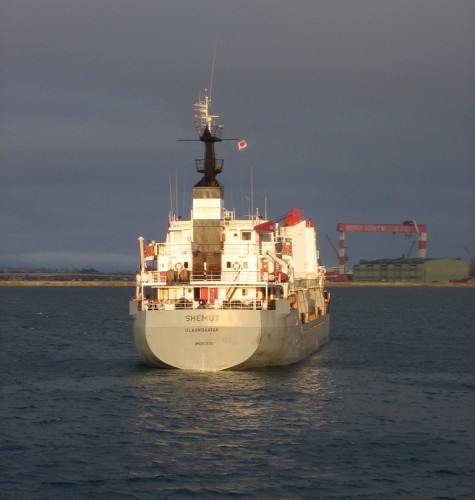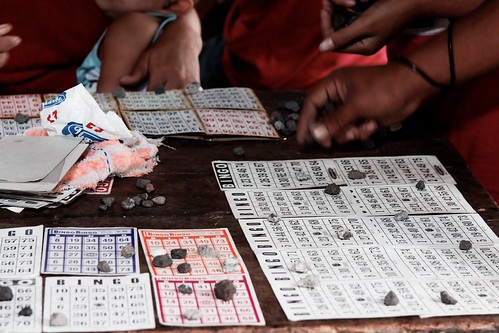March 17, 2009
Despite having our plans of riding the ill-named “Bikol Express” Southrail train from Manila to Legazpi “derailed“, Joosje and I manage to get there by night bus from Manila. We arrive about 9.30AM, exhausted as all hell, catch a tricycle to the Legazpi Tourist Inn (which was the only hotel I have ever been to in the world where they let you stay for two nights and don’ t even ask to see money until you checkout.) It’s raining.
We wander towards the docks, realize you can’t get far down in that direction due to concrete walls and construction barriers, and then instead head into “Victory Village”, which looks from the outside to be a small fish market area on the other side of the concrete wall, through an archway. It turns out to be a 6000 person Barangay (Filipino word for village or neighborhood, which was chosen to replace the Spanish-era word “barrio”). We chat with many people, all very friendly, as we wander through the narrow streets-if you can evven call such narrow pedestrian-only alleys streets, and then a woman tells us we can climb the hill behind the village to get a view of the city and huge volcano (Mt Mayon) beyond. The rain has stopped, and the sun is out. A 12 year old girl, an 18 year old girl, her dog Pipi, and two boys who unusually don’t seem to know any English at all take us slipping and sliding up the hill for an amazing view and after taking it in we slip and slide back down, through what seems to be a mix of mud from the earlier rain and caribou shit, back down to the village. To get onto the path up to the lookout point you have to slip through a barb-wired fence, which is little physical obstical but would probably keep out most un-invited visitors due to appearances.
After we get back down, the woman who had pointed out the way up the hill waves us over to talk. She first introduces herself, Julie T. Bahoy, and then asks if we want to go see the docks and construction site behind the barriers we had balked at earlier. The Barangay runs parallel to the docks area, entirely cut off from it by a tall concrete wall which is prettied up on the dock-facing side but ugly, bare concrete on the village side, aside from the market entrance we had taken, another opening in the middle, and one gate into the construction area and fishing docks. Julie tells us that the construction is for a major tourist destination and resort project known as The Embarcadero. (The project and name both seem inspired by San Francisco’s Embarcadero.) The Embercadero construction has made it more difficult for the villagers to reach their fishing piers, which can only be reached by traversing the construction site itself. Only village residents are supposed to be allowed out to the fishing pier, but Julie says that if anyone asks she will just tell them that she wants to show her friends the fishing boats and not The Embarcadero. In fact, none of the guards or construction workers are very interested, but Julie seems to ejoy the thought of getting away with something.
After looking around the pier area we walk back into the village and have a seat at a small shop run by her mother. She gives us bottles of generic brand cola and some chocolate snack-cake thing and tells us about herself. The fishing village within Legazpi cityis her home town, and she is educated in a nearby college, with a major in business management. After graduation she was unable to actually work in that field, instead getting a clerical job in a law office, which she did for many years before switching to her current job managing a small office in the city. It does not pay particularly well, and she has some side jobs trading various goods, sometimes involving networking with her sister in Manila, particularly apaca fiber products for export. She might be able to find a better job with higher pay, but says that the company she works at would fail without her, and she does not want to be responsible for putting the others out of work. Yet, she also does not demand higher pay. Her father is a retired machinist for the electrical utility, draws a small pension, and continues to do some machining work from a home shop.
Although much of her time is of course occupied by her dayjob, Julie’s real vocation has been her work on the Barangay Council, where she is the youngets of its seven members. She was first elected as the youth representative at the age of 18 and is now nearing the end of her third, and term-limited final, term. She has always ran, and been elected, as an independent and refrained from the bribe and gift exchanges ubiquitous in local Philippine politics, facts that she is very proud of. She even uses her small honorarium as a council member for purchasing things needed by the village, such as lights, instead of keeping it as a payment. Approaching the end of her final term she is wrestling with the decision of whether or not to try and run for council chairperson, as some are urging her to do, but is reluctant to do so out of concern that it may be difficult to do so without engaging in the standard corrupt politicking and that it would occupy even more of the time she needs to make money for her family, a conundrum traditionally solved by engaging in the corruption which she so abhors.
Still, she is considering giving it a shot so that she can work for the barangay. And the barangay needs help, fenced in and under threat due to the Embarcadero project. 95% of the village population survives in one way or another from the fising trade, with only about 1 in 20 engaged in external occupations in the city. Naturally, anything that obstructs their access to the sea is a serious threat. While some villagers have temporary work during the construction phase, few of them have enough education to apply for the permanent jobs that will be created upon its completion. There is a free public elementary school inside the village, and like all of the schools I have seen in The Philippines so far it is pleasant and well maintained (the newspapers reported this past week that the Department of Education was rated least corrupt governmeent department in a public opinion survey) but higher education requires travel outside into the city, which few of the fishing families have the hard currency for.
There are rumors that the project is partially owned by Philippine President Gloria Macapagal-Arroyo (always referred to as GMA here), widely considered to be corrupt (one recent survey pegged her as even more corrupt than the late Ferdinand Marcos, which while highly unlikely at least gives a sense of the level of discontent) or at least one of her friends. The wall was constructed without permission of or consultation with the barangay or any of its residents, and unsurprisingly cut across some private land. According to Julie, the Bahoy family house’s lot extends a full 25 meters past the wall, and they have a lawsuit pending over the theft of their land. She says that the developers have offfered to settle for the fairly hefty sum of 20 million pesos (around USD $500,000), but they have documents showing clear title to the land and are not interested in settling. Such a settlement offer implies that they have a strong case, and she even hopes to have the wall itself removed. Unfortunately, many of the other residents lack proper documentation and are even legally considered to be squatting in their own homes, and have no hope of filing a similar lawsuit. Such carelessness in basic legal matters is an obvious result of under-education, but fishing has not historically been an occupation with a great need for men of letters. And with the fishing at risk, they have little or nothing to fall back on. More of the children stay in school than their elders, but probably still not enough. In the face of this situation, I expect that Julie will find herself unable to not run for barangay council president, and will sleep even less.
(As will all entries in this series, this will be reposted with photos added some time after my return to Japan.)





